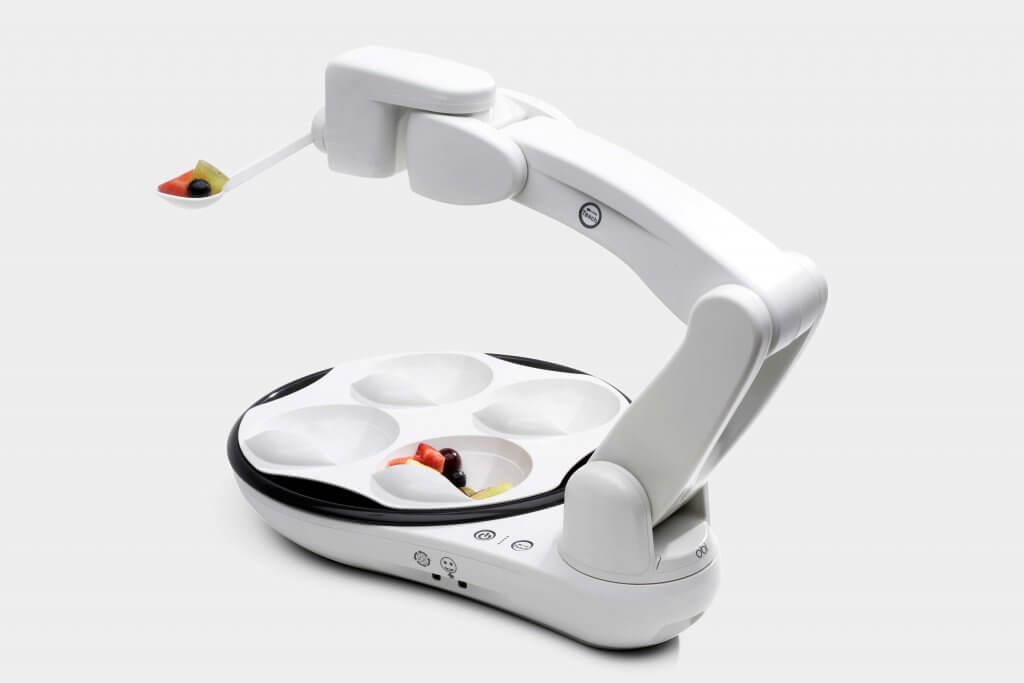This article was written by a licensed Occupational Therapist.
Eating and drinking are important acts of self-care that give our bodies essential nutrients and energy.

If someone becomes overly fatigued or struggles while trying to feed themselves, it can counteract the benefits of food consumption.
Relying on caregiver assistance as a solution to feeding problems means the diner is unable to control the pace of eating, and pressure to eat rapidly can increase the risk of pneumogastric conditions such as aspiration and GERD. Therefore, preserving a person’s independence during mealtime is important.
Adaptive devices for eating and drinking can help those who have trouble with self-feeding. They not only make it easier for individuals to dine on their own but may also help reduce symptoms associated with malnutrition by increasing caloric intake and nutritional health.
Here’s a list of four adaptive eating and drinking aids, from simple dishware to robotic technology:
1. Clip-On Straw
Straws are generally considered the easiest drinking option for individuals with disabilities because they don’t require picking up a glass or mug and bringing it to the mouth. However, traditional straws are often too mobile and move around freely in cups, making it difficult for individuals with poor coordination to reach them.
Using a clip-on hook to affix the straw to the side of the cup keeps the straw in one place while someone drinks. Clip-on straws also prevent the need for readjustment before taking the next sip.
2. Obi Adaptive Feeding Device
 Obi is an adaptive eating robot that allows individuals with limitations in their upper extremities to feed themselves.
Obi is an adaptive eating robot that allows individuals with limitations in their upper extremities to feed themselves.
Diners use customizable accessibility switches to chose what they want to eat and when. The switches move the arm and spoon between four bowls of food or drink. A hand-guided teach mode function allows users to set up a spoon delivery position that works comfortably for the diner.
This adaptive eating device is highly calibrated to ensure smooth movement and effective food capture, so there are less spills and messes to clean up after meals. Despite its advanced technology, Obi is simple and easy to use for diners as young as five years old all the way up to senior citizens. An intuitive eating device like Obi Robot allows individuals with disabilities to sustain their independence and play a more active role in feeding themselves.
3. Nosey Drinking Cup
Nosey Cups feature a cutout space opposite the sipping side to accommodate a person’s nose. This means that, when the cup is filled to a certain height, individuals can drink from it without needing to tip it back.
Adaptive drinking devices such as the Nosey Cup are ideal for those with head, neck, or upper extremity limitations, oral-motor dysfunction, or throat-related feeding difficulties such as dysphasia. Cutout cups made from flexible plastic can be gently squeezed to change the shape of the cup lip to direct liquid flow; they’re also easy for individuals with decreased grip strength to handle.
4. Scooper Bowl
The main advantage of a scooper bowl (also available as a scooper plate) is its raised sides that serve as a barrier to prevent food from easily spilling out. This allows the diner to use the walls of the bowl or plate to assist them in scooping food onto their eating utensil.
These bowls are made of durable, stain-resistant materials and often come with an adaptive ergonomic handle that makes it easier for diners to hold onto while eating. Scooper bowls and plates can also come with suction placemats that keep the containers safely in one place and prevent them from sliding around the table as diners attempt to scoop or cut up food.
–
There are a range of low- and high-tech adaptive eating and drinking devices available to assist individuals who have difficulty eating and drinking.
Anyone interested in self-feeding aids should contact their doctor or therapist to learn more about whether they’re a good candidate, how to obtain equipment, and important considerations for use. Adaptive dining devices could mean the difference between a stressful and enjoyable mealtime experience!


